
Distance: 12.3 miles
Start/finish: Start at King’s Langley Station, Station Road (pay car park. London Northwestern Line services). Finish at Shenley Park car park (free) off Radlett Lane, Radlett.
Map: Ordnance Survey Explorer map 182 and 173.
Public transport: The 602 stops outside Shenley Park in Radlett Lane, at Porters Park Drive opposite Fielders Way – a 10 minute walk via footpaths behind Shenley Park – and goes to High Street, Watford, Radlett, St Albans (Thameslink) and Hatfield stations (East Coast Main Line) and many stops in between. Log on to bustimes.org.uk for timetable. None of the stations directly link to King’s Langley. The 658 stops near the former Black Lion pub in Shenleybury and in Porters Park Drive opposite Fielders Way and continues to St Albans City station. bustimes.org.uk The best way of travelling between King’s Langley and Shenley and vice versa – apart from car/taxi – is to take the 602 from just outside Shenley Park to High Street Watford, walk to Watford Junction station (seven minutes) and take the train to King’s Langley.
Pubs/refreshments:
Route description: The motorways, the distant skyline, the hum of near London traffic and the tell-tale march of the electricity pylons are a giveaway. On this leg you are approaching the outlying London boroughs and the southernmost point of the entire 195 miles – fittingly a pond – in the film set village of Letchmore Heath before you head back north to Royston. Even though there is growing evidence that ‘The Smoke’ is extending its sclerotic grasp ever northwards Hertfordshire still maintains an unruffled bucolic air on this leg despite the unwanted attentions of the M1, M25, the old Watling Street and the A405 arterial road. King’s Langley to Bricket Wood’s user-friendly common – bisected by the one-track Abbey Line and with its herd of muntjac deer and occasionally grazing longhorn cattle – leads you through a varied and truly scenic few miles across the parkland of the well-ordered Munden estate to the photogenic villages of Aldenham and Letchmore Heath. Then, identifying rarely visited tracks and paths, the Way quietly heads through what feels like unexplored territory as the landscape slowly climbs amid undulating farmland and unannounced twists and turns to Shenley. I have lived at the heart of this stretch, namely Bricket Wood, for more than 35 years. I thought the landscape for miles around the village was a familiar friend. But as the miles passed after leaving Aldenham it truly was – with apologies to Shakespeare and Hamlet’s search for answers – an undiscovered country. Fortunately this traveller returned.
King’s Langley can claim to have the strongest royal link of any place the Hertfordshire Way passes through. It was home to a 13th century royal palace of the Plantagenet kings of England built on a hill above the village to the west. When Edward III moved his court out of London in July 1349 to escape the ravages of the Black Death the palace became, temporarily, the seat of government with religious relics from the Tower of London transferred there for safekeeping. The palace fell into disrepair during the 16th century after the dissolution of the monasteries and became a ruin. Today nothing remains above ground level at what is now a scheduled ancient monument. A Dominican priory was founded next to the palace, remains of which can be seen. The parish church of All Saints, built during the 14th century on the site of an earlier building, contains the tomb of Edmund of Langley, the first Duke of York, who died in 1402. The body of Richard II was buried there for a time after his probable murder in Pontefract Castle in 1400 before being moved to Westminster Abbey. The place name Langley first appeared in a Saxon charter in 1050, became Langelai in the Domesday Book and then Langel’ Regis in 1254 to mark its royal patronage. The name means “long wood or clearing.” The village developed straddling the old road from London to Berkhamsted and the Midlands which in the 18th century was part of the Sparrow Herne turnpike road (later the A41 with coaches stopping at the 16th century Saracens Head pub in the high street). The topography of King’s Langley has historically attracted new forms of transport including the Grand Union Canal, which arrived in the late 18th century, to what would become the West Coast Mail Line which began running services 40 years later. One of the village’s most iconic landmarks is the old Ovaltine building with its listed façade which is situated alongside the canal. In the 1950s 1,400 people worked there. It is now flats and apartments.
In fact, the Ovaltine factory provides a fitting backdrop as you leave King’s Langley station and turn right to embark on your journey to a leafier, quieter and more attractive Shenley. Walk along Station Road until you reach Egg Farm Lane (presumably the name has something to do with Ovaltine’s own egg producing farm which supplied the factory from the fields nearby). Go under the railway bridge and take the drive right up a tarmac road climbing slightly in the grotesque shadow of the area’s only – as far as I know, and I hope it is – wind turbine in the grounds of the RES complex (below left and right).
NB This is a new start to the walk. The route described in the first two editions of the official guide, which headed left after the railway bridge, is no longer used, possibly because it was a permitted path and that permission has been rescinded.
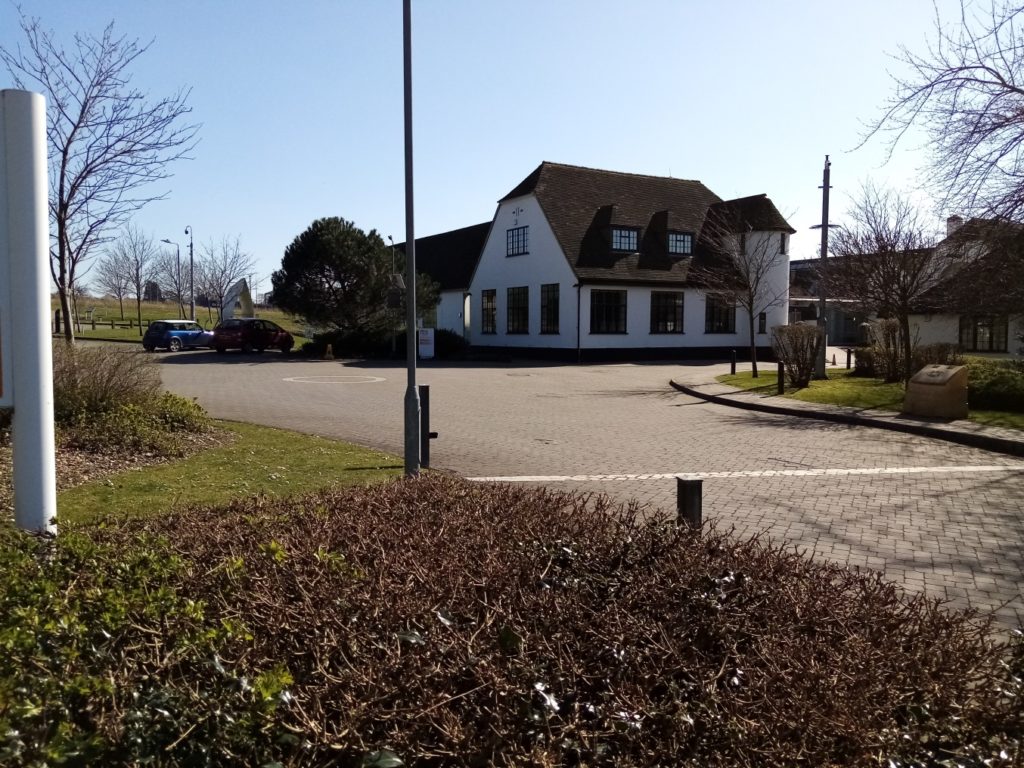
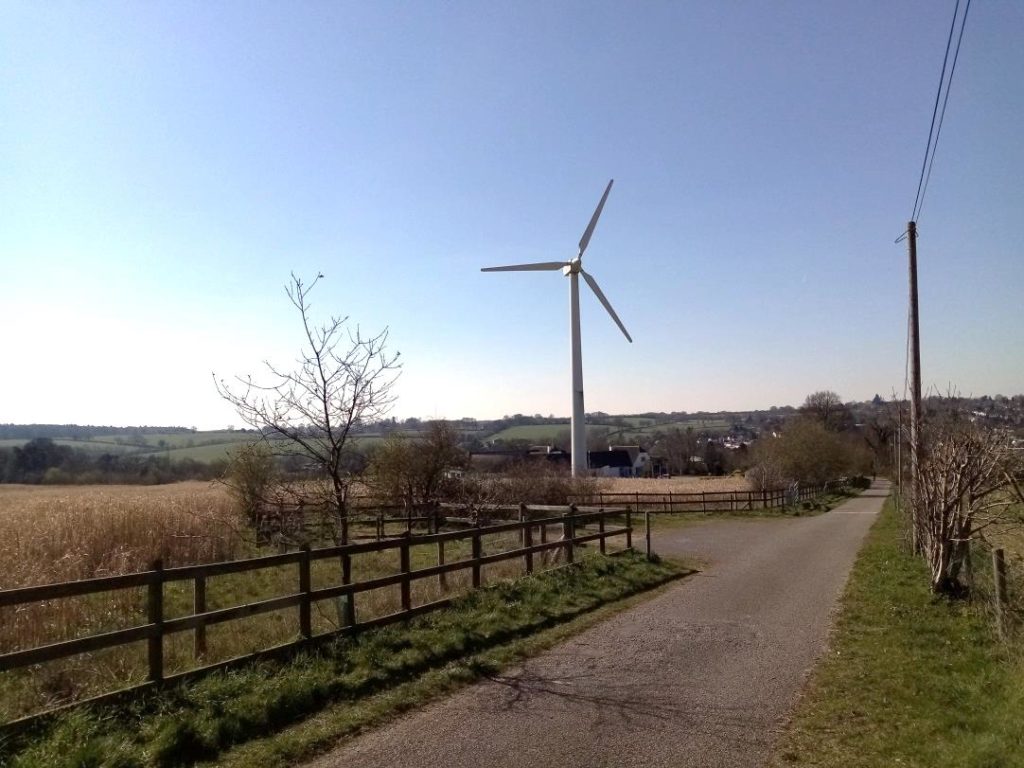
I could spend the years before I receive my old age pension – some time yet – ranting about the expensive, inefficient, illusory, heavily taxpayer subsidised ‘Green’ masquerade, described by one Environment Secretary as a “failed medieval technology,” that wind turbines are. At least to this sneering sceptic. But as walking is allegedly a relaxing communion with the natural world and one’s sore feet I’ll leave such saloon bar polemics to a post trek pint or two. Ironically, if you were minded to have an audible rant about the iniquities of wind turbines, if you share my misgivings, that is, then you are within earshot (OK assuming the M25 comes to a silent halt) of the ultimate champion of Green technology. Renewable Energy Systems has its headquarters at Beaufort Court at the foot of the turbine centred around the old Arts and Crafts-style Ovaltine Egg Farm originally built in 1929 and now converted and added to. RES has been a pioneer of cutting-edge green technology for nearly 35 years and is now a global force. That 225 kW turbine – we will agree to disagree – supplies the RES complex with power, along with a large wall of solar panels and a biomass boiler which provides heat, and has the additional capacity to supply 40 homes. Sorry but I didn’t have a Damascene conversion standing outside the gates of RES.
Continue up the road to a wooden seat and admire the panoramic views of the Ovaltine building and Kings Langley (below).
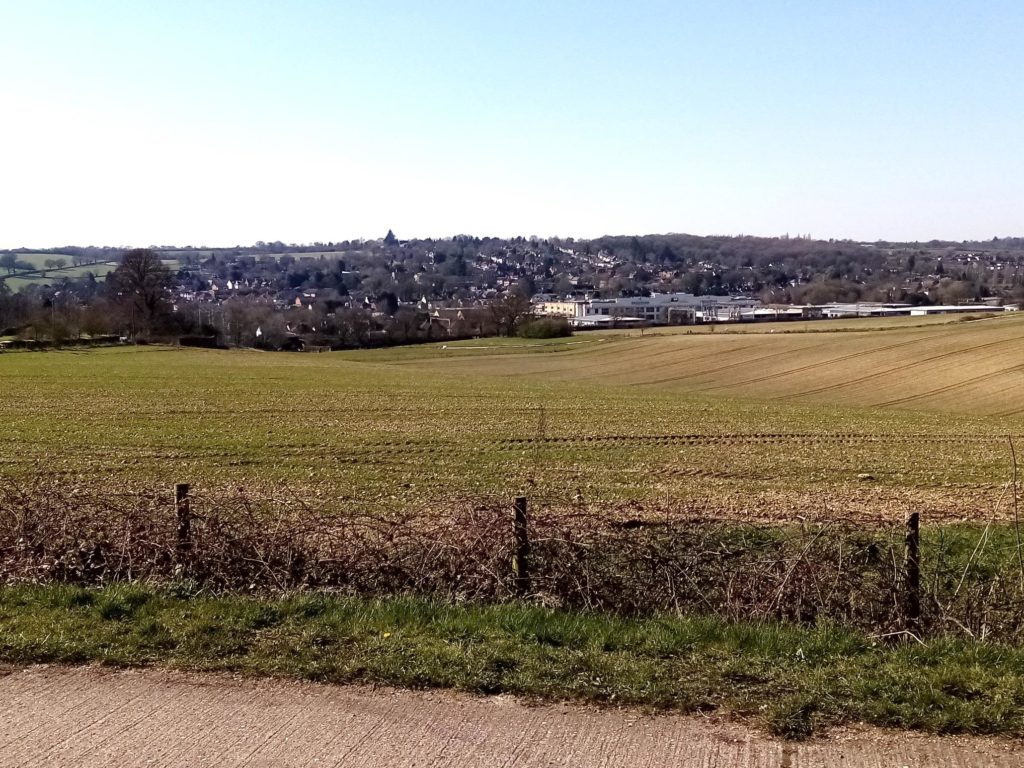
Follow the road as it crosses the M25 to an isolated property. (What a bar room boast. “I’ve got my own bridge over the M25.”) The road becomes a broad track which soon gives you the option of turning right (as advocated by the official guidebook) or continuing straight on (as instructed by the HW roundel high on a metal post: March 2020). It doesn’t matter either way. The two routes are the opposite sides of the same rectangle.
I’d suggest walking on to the second turning as you aren’t hemmed in by bushes on a narrow path without relief. By continuing ahead you’ll be in the company of arable fields with open views. (see below). When you turn right, either at the first junction or at the second T junction at a metal farm gate, you’ll join a footpath running behind houses in Abbots Langley. Turn left and walk to join Dairy Lane at a kissing gate alongside Abbots Langley School. At Bedmond Road turn right and at the pedestrian crossing go over and turn left, then right into Love Lane.
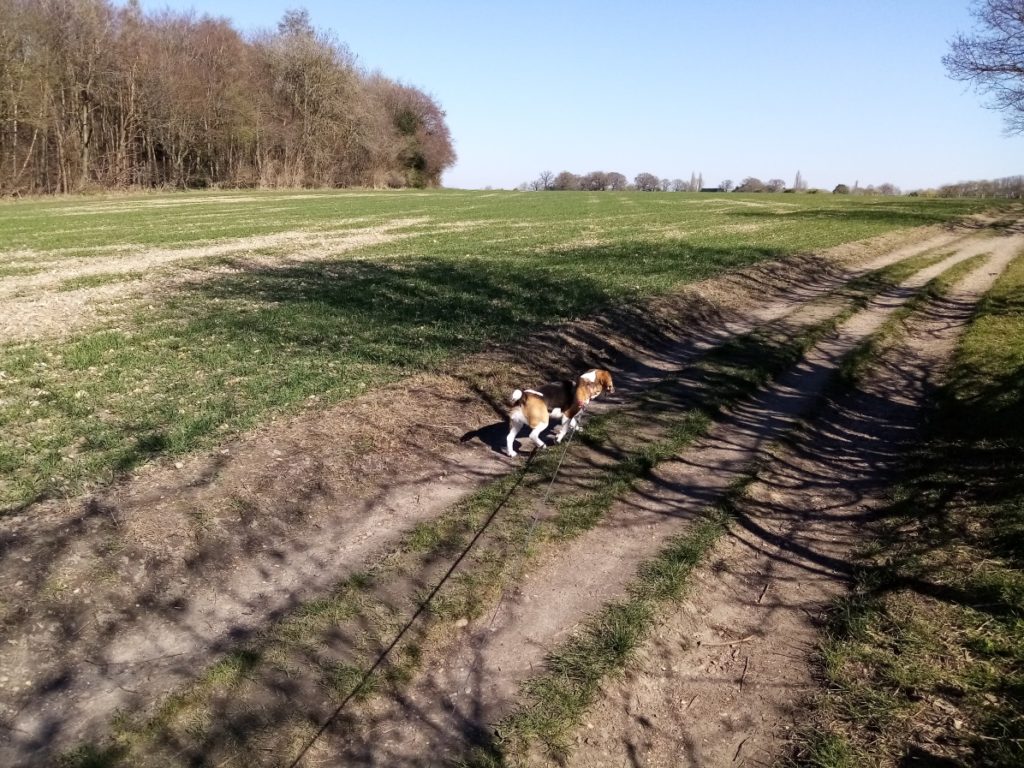
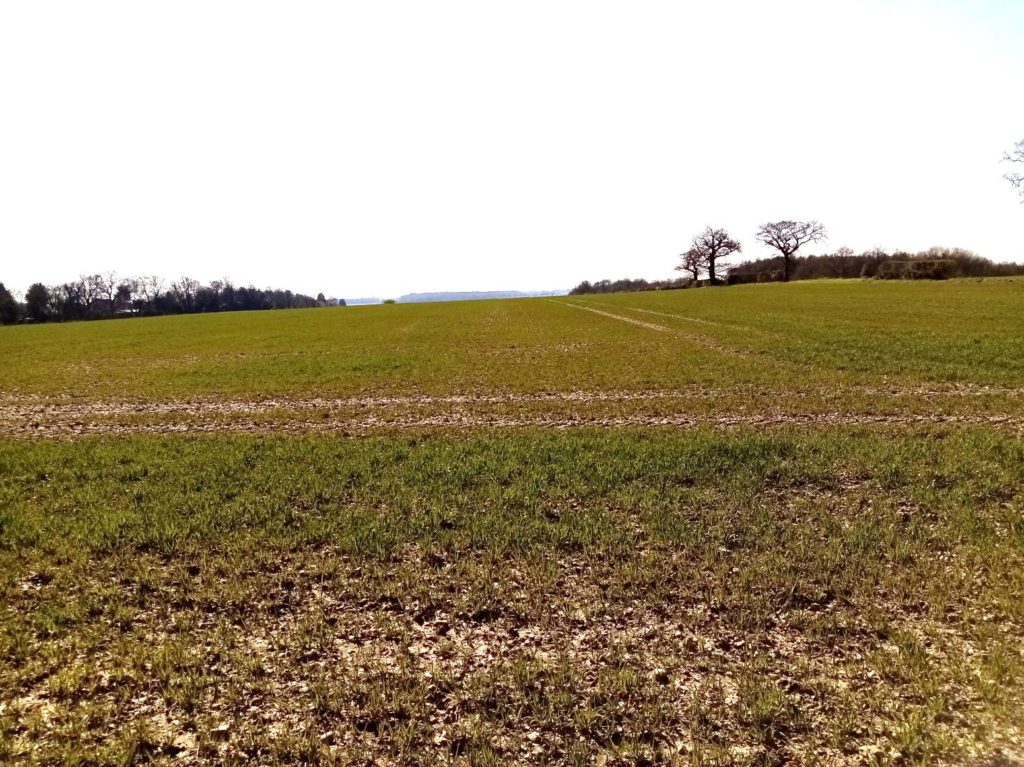
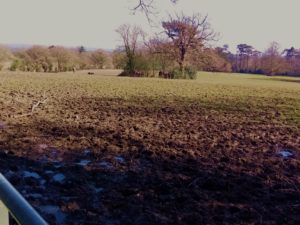 The path skirts the backs of houses before entering a recreation ground with one of the most user-friendly park goals I’ve seen. No running to get the ball after you’ve scored because the net’s torn, or there isn’t a net at all. It’ll simply rebound out. Wide shots will also bounce back off the steel framework. Three-and-in becomes a less time- wasting kick about. What’s not to like? To those of us who piled up jumpers for goal posts it was a revelation. Anyway, continue on a path between hedges and across a broad field (left) towards a clearly visible kissing gate (below).
The path skirts the backs of houses before entering a recreation ground with one of the most user-friendly park goals I’ve seen. No running to get the ball after you’ve scored because the net’s torn, or there isn’t a net at all. It’ll simply rebound out. Wide shots will also bounce back off the steel framework. Three-and-in becomes a less time- wasting kick about. What’s not to like? To those of us who piled up jumpers for goal posts it was a revelation. Anyway, continue on a path between hedges and across a broad field (left) towards a clearly visible kissing gate (below).
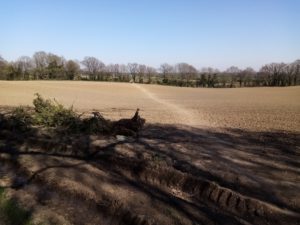
Cross a sunken track and follow the path downhill to a hedge. Turn right ignoring a footpath on the left and then a bridleway which also joins from the left. This is the original route of the Hertfordshire Way via Bedmond. Continue on the bridleway, ignoring the footpath on the right, until you reach a metal gate at Chequers Lane. Turn left, there are no pavements so be careful to avoid often heavy traffic, and almost immediately on your right opposite Waterdale Cottage – the HW roundel is at the top of a metal post (this is also a minor change from the original route as outlined in the first two editions of the guidebook) – and follow the path ahead with the hedge on your right. There is a parallel grassy alternative on the other side that walkers sometimes take. Continue between fences when you reach Fortunes Farm, stopping off at the gate to admire the menagerie of wildfowl, chickens, goats and horses, the birds kept in high class enclosures that would shame the most monied zoo.
More curiously, if you peek over the hedge, is a concrete pillbox stuck in the garden. An original or an ersatz folly? But as you’ll encounter a few dotting Potters Bar Golf Club on the next section of the walk – part of a World War II defensive ring around the north of London – I’d hope it was a piece of our history. I’d love one in my garden! When you reach High Elms Lane turn left.
 Continue past Parmiters School (ignore the footpath on your left which is where the HW use to appear) and West Herts Crematorium to the A405. Cross over High Elms Lane and take the subway to Bucknalls Lane, Turn left and walk the length of the road to the Building Research Establishment (below-right) after crossing the M1 motorway before entering a narrowing bridleway. Continue until Bricket Wood common opens in front of you. The walk now becomes a lot more interesting.
Continue past Parmiters School (ignore the footpath on your left which is where the HW use to appear) and West Herts Crematorium to the A405. Cross over High Elms Lane and take the subway to Bucknalls Lane, Turn left and walk the length of the road to the Building Research Establishment (below-right) after crossing the M1 motorway before entering a narrowing bridleway. Continue until Bricket Wood common opens in front of you. The walk now becomes a lot more interesting.

The former Government owned Building Research Establishment has been in existence for more than 90 years. It carries out research, consultancy and testing for the construction and built environment sectors in the UK. The then Building Research Station moved to Watford in 1925 occupying Bucknalls, a large Victorian house which is still there, and 38 acres of land. During World War II staff helped create a 1/50th scale model of the Mohne Dam used by Barnes Wallis during his early research into the now legendary bouncing bomb. The BRE holds an annual public open day, the highlight of which for many is discovering the remains of the dam mock-up – with a distinctive V missing from its centre where the mini bombs were exploded – in woodland on the site. It holds back a small pond so water often trickles through the gap. Many years ago when working for BBC London News I filmed a weekly four minute feature which was broadcast at 6.30pm called The Max Files, fronted by the former president of the Royal Institute of British Architects Maxwell Hutchinson. One week we filmed a behind the scenes feature on the unseen and unsung work of the BRE, including a section in its unparalleled ‘library’ of woods from around the world and a room where the eerie sound of wood devouring insects could be heard. It’s a fascinating place that– through its research into eco-friendly, energy efficient and robust properties, fire safety measures and its testing of the homes of the future – has a huge impact on the built world and our lives. www.bre.co.uk
When you reach Bricket Wood common at a crossroads of paths a Hertfordshire Way sign will clearly direct you right on to a wide and easily followed path that rises to a bridge across the Abbey Flyer line (Watford Junction to St Albans Abbey) and then straight on past a fenced enclosure on a hugely improved and enjoyable path to School Lane. Just before reaching the road, out of sight but just a few yards to your left, is the common’s main pond.
Bricket Wood common is a 212 acre gem, a bolt-hole for villagers from the irritations of everyday life. Although it sadly rubs shoulders with the urban sprawl of north Watford and sits uncomfortably close to the swish of the M1, the sense of solitude is tangible and its seasonal variations a constant delight. Although it can’t compete with the Ashridge estate or Berkhamsted Common for size, it is a remnant of rare lowland heath and is protected and recognized nationally as a Site of Special Scientific Interest, a status conferred in 1953 because of its wildlife. In recent years 27 butterfly species have been recorded, one of the highest totals in Hertfordshire, and it is perhaps the most important site in the county for fungi. The main pond (below right) is home to all three native species of newts (the great crested, the smooth and the palmate.) Great crested newts have full legal protection under UK law making it an offence to even disturb them or their habitat.


The common, which is part of the Munden estate, has a history spanning thousands of years. Belgic tribes are believed to have travelled up the Ver and Colne and camped alongside it. Later the Romans built villas along the rivers and created a network of tracks across the common. It has, however, never been used for agriculture. Its heavy, claggy boulder clay, poor drainage, acid grassland and wet heathland only left grazing and wood-cutting for commoners to exploit. They traditionally kept the trees at bay. But when those activities ceased woodland took over smothering the important heathland habitats. A project to restore the heathland and acid grassland – and encourage the reappearance of its distinctive flora – begun in 2001 when just over four hectares of secondary woodland was felled to open up the woodland floor. An eight hectare fenced area is grazed by longhorn cattle in spring and autumn. Muntjac deer also roam the common, best seen grazing at dawn or dusk. The woodland management programme includes the planting of new trees and small copses and a large number of willows grown under contract with Gray Nicols, the cricket bat manufacturers.
Wikipedia.org/wiki/Bricket Wood Common; bricketwood.org/woodlands-wildlife-and-walks/bricket-wood-common; stalbans.gov.uk Parks and green spaces . Green Spaces and commons
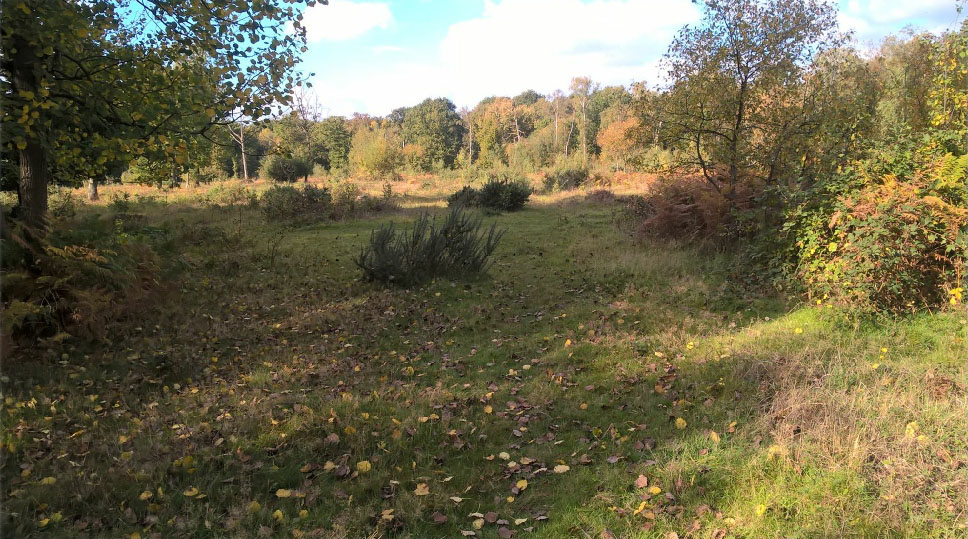
 On reaching School Lane turn right and immediately left by the houses onto the Munden estate. Cattle grid optional. Follow the road until the woods open out and parkland and pasture appear. Head for the kissing gate in the fence on the right – signposted – and then head diagonally across the estate (below left). (A charming detour to the much photographed ford and bridge across the Colne just below Munden House (see left) can be reached by ignoring the kissing gate, continuing on towards the estate cottages and taking the gate to their left. A short track leads you down to the Colne where you can paddle, stand on the bridge and watch the fish or admire the 30 room, 18th century Munden House and gardens. After retracing your steps head across the parkland of the 850 acre estate (top left) keeping left of the clumps of trees until you reach its metalled access road. On your left is an impressive collection of different trees in the grounds of Munden House (below right).
On reaching School Lane turn right and immediately left by the houses onto the Munden estate. Cattle grid optional. Follow the road until the woods open out and parkland and pasture appear. Head for the kissing gate in the fence on the right – signposted – and then head diagonally across the estate (below left). (A charming detour to the much photographed ford and bridge across the Colne just below Munden House (see left) can be reached by ignoring the kissing gate, continuing on towards the estate cottages and taking the gate to their left. A short track leads you down to the Colne where you can paddle, stand on the bridge and watch the fish or admire the 30 room, 18th century Munden House and gardens. After retracing your steps head across the parkland of the 850 acre estate (top left) keeping left of the clumps of trees until you reach its metalled access road. On your left is an impressive collection of different trees in the grounds of Munden House (below right).
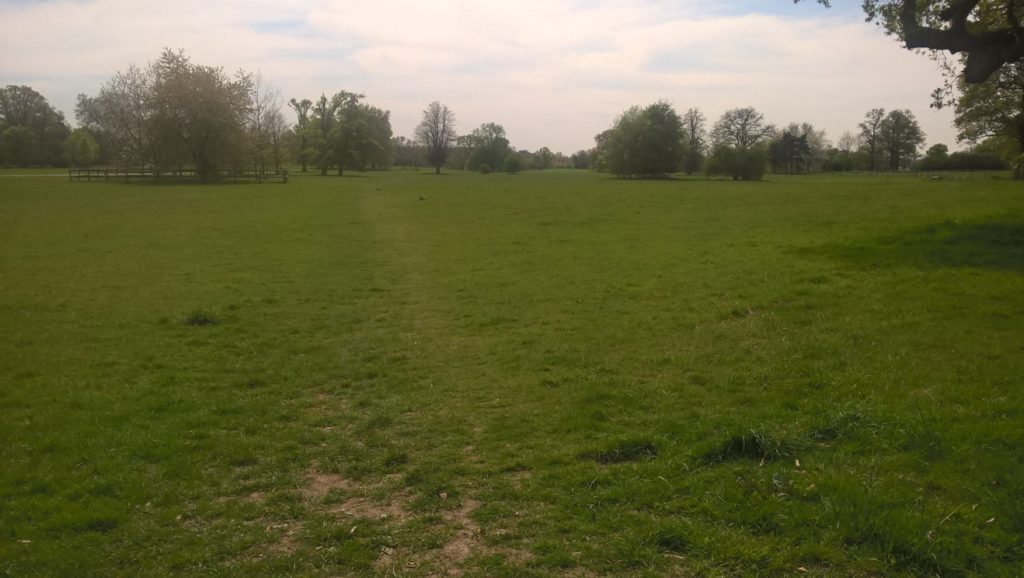
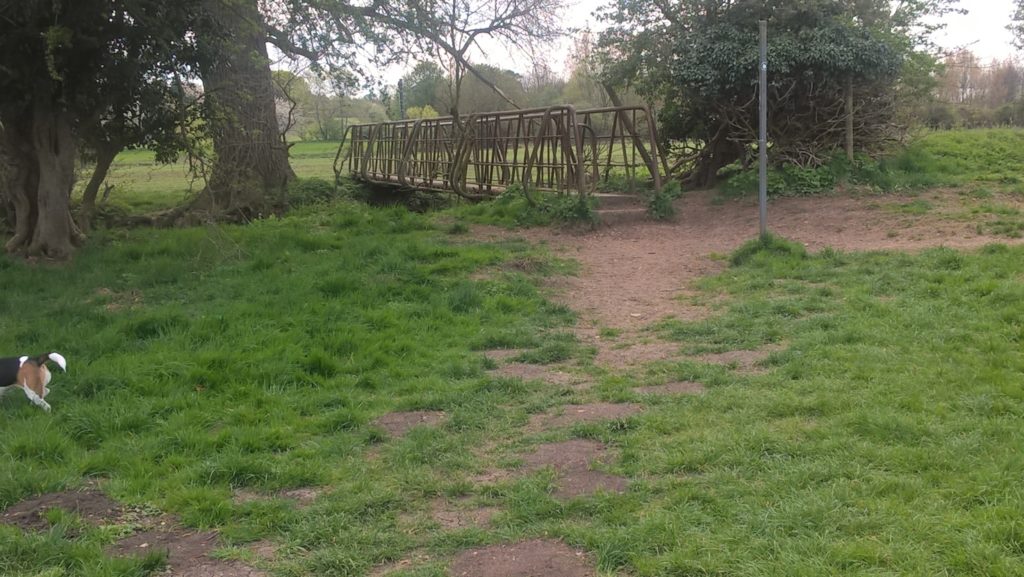
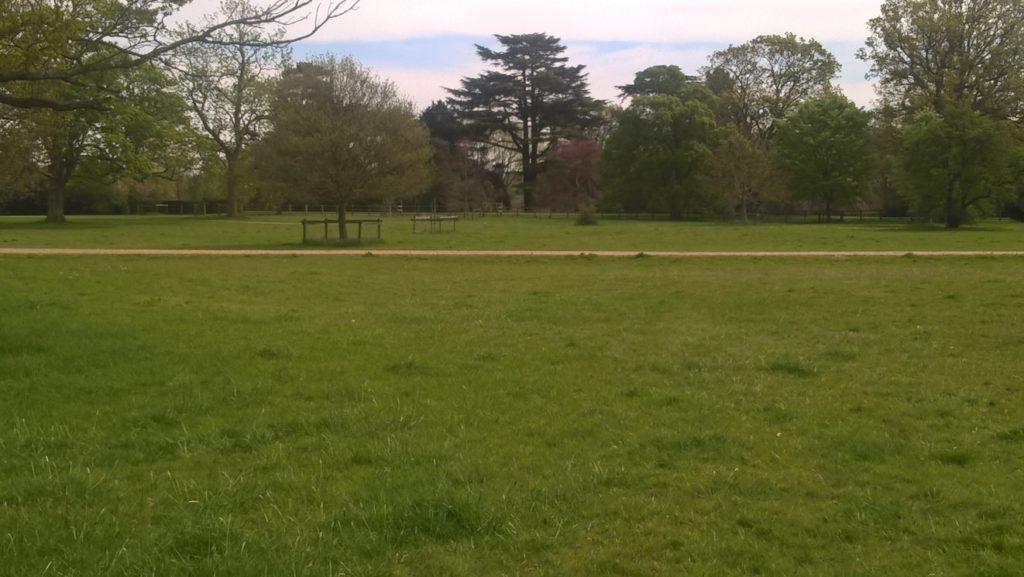

Cross in the same direction and drop down to a constructed concrete and metal bridge across the river (above). It doesn’t flatter the more rotund members of the walking community. Continue across the farmland on what is normally a strikingly obvious path to a now largely redundant wooden bridge spanning a river bed (below left) which, since the relaying of the Colne Valley drainage system, carries a trickle of water only in wet weather. Records show it was once a deep, clear stream where otters played. Continue straight on up the track opposite to reach Wall Hall and its 56 acre estate. On the right is Aldenham Golf Club where the 13th hole at 621 yards was once the longest in Europe. It’s a par five. Or in my case a short holiday.
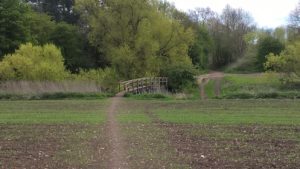 Wall Hall (below) is a turreted and castellated Gothic style house built in 1802 and originally called Aldenham Abbey. It was formerly the home of the famous American banker J. P. Morgan who bought the 300 acre estate in 1910 and renamed it Wall Hall where he entertained the Royal family and the cream of society. During World War II it served as the residence of the American ambassador, Joseph Kennedy; the father of JFK. In 1945 it was converted to a teacher training college, later becoming part of the University of Hertfordshire. In 2007 the house and other listed buildings on the now 56 acre site were converted into 25 homes with another 76 houses and flats built within the stylish and private grounds.
Wall Hall (below) is a turreted and castellated Gothic style house built in 1802 and originally called Aldenham Abbey. It was formerly the home of the famous American banker J. P. Morgan who bought the 300 acre estate in 1910 and renamed it Wall Hall where he entertained the Royal family and the cream of society. During World War II it served as the residence of the American ambassador, Joseph Kennedy; the father of JFK. In 1945 it was converted to a teacher training college, later becoming part of the University of Hertfordshire. In 2007 the house and other listed buildings on the now 56 acre site were converted into 25 homes with another 76 houses and flats built within the stylish and private grounds.

With Wall Hall on your left pass the new homes and bear right in front of a large wooden barn staying on the left hand side of the drive. On your left, with the distinctive spire of Aldenham’s St John’s the Baptist Church on the skyline (below left), find the footpath which heads straight across the field towards some hedges. Don’t continue straight on when you reach the hedge. Turn right around the perimeter of the cultivated land and drop down between houses into Red Lion Close. You emerge virtually opposite the lych gate of St John’s. Before continuing on the day’s walk take time to explore Aldenham, unsurprisingly a conservation area but surprisingly still retaining its historic seclusion despite the M1, the busy A41 and the dreary rush-hour traffic just a mile away which seem to perpetually threaten its peace and charm.
 Aldenham was mentioned in the Domesday Book and has eight pre-19th century listed buildings. Wonderfully the parish has remained largely unchanged over the centuries although it is probably a lot smaller than 500 years ago when lands were sold off after the Reformation. The church of St John the Baptist is at least 700 years old although there is evidence to suggest an earlier Saxon Church stood on the site – or may even have been used for pre-Christian worship. The earliest available document to mention the current church is dated 1267 and relates to the appointment of a vicar. Inside the beautiful interior (for more information log on to www.aldenhamchurch.com) are two windows dedicated to the memory of the crew of HMS Aldenham, a Royal Navy Hunt Class Destroyer- named after the Aldenham fox hunt – that was sunk in the Adriatic on December 14, 1944, after hitting a mine. Of the 126 crewmen only 63 men were rescued. A memorial service is held at the church each December. In 1940 a German air attack damaged stained glass and the distinctive spire – known as a Hertfordshire Spike. It wasn’t until 1950 that restoration work was complete. One wonders what the Luftwaffe were trying to bomb but ending up hitting Aldenham. Perhaps those supposedly strategically placed pill boxes along the River Colne which still exist in places! No. Put it down to a myopic bomb-aimer. With its village green, social and cricket club and, remarkably, its own golf course Aldenham is a quintessential English village you might unexpectedly discover tucked into the folds of the South Downs. It has it all, apart from a thatched village pub. But we’ll forgive it that historic lapse. So close to the unwanted incursion of London life but still a treasure. wikipaedia.org/wiki/Aldenham
Aldenham was mentioned in the Domesday Book and has eight pre-19th century listed buildings. Wonderfully the parish has remained largely unchanged over the centuries although it is probably a lot smaller than 500 years ago when lands were sold off after the Reformation. The church of St John the Baptist is at least 700 years old although there is evidence to suggest an earlier Saxon Church stood on the site – or may even have been used for pre-Christian worship. The earliest available document to mention the current church is dated 1267 and relates to the appointment of a vicar. Inside the beautiful interior (for more information log on to www.aldenhamchurch.com) are two windows dedicated to the memory of the crew of HMS Aldenham, a Royal Navy Hunt Class Destroyer- named after the Aldenham fox hunt – that was sunk in the Adriatic on December 14, 1944, after hitting a mine. Of the 126 crewmen only 63 men were rescued. A memorial service is held at the church each December. In 1940 a German air attack damaged stained glass and the distinctive spire – known as a Hertfordshire Spike. It wasn’t until 1950 that restoration work was complete. One wonders what the Luftwaffe were trying to bomb but ending up hitting Aldenham. Perhaps those supposedly strategically placed pill boxes along the River Colne which still exist in places! No. Put it down to a myopic bomb-aimer. With its village green, social and cricket club and, remarkably, its own golf course Aldenham is a quintessential English village you might unexpectedly discover tucked into the folds of the South Downs. It has it all, apart from a thatched village pub. But we’ll forgive it that historic lapse. So close to the unwanted incursion of London life but still a treasure. wikipaedia.org/wiki/Aldenham
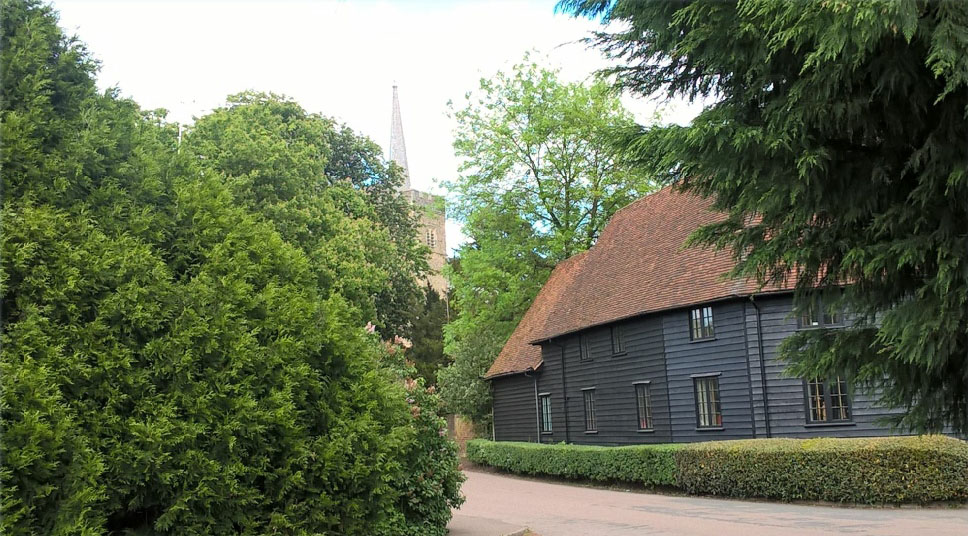

 Leave Aldenham through the churchyard. From the lych gate walk up to the church, turn right then turn left, pass the main door and find a grassy path virtually straight ahead alongside a wall that leads to Church Close. Cross Aldenham Road – beware it is often busy and cars speed – and, if you’re in need of refreshment, walk 80 yards down Round Bush Lane to the superb 17th century Round Bush. If you’re bold enough to eschew the delights of a pint of decent real ale walk past the cottages which start at the top of Round Bush Lane into The Spinney. At the top of the road cross Primrose Lane and find ahead of you a bridleway which drops right to Letchmore Heath (left). On reaching Grange Lane turn left into the village and at the fork right into The Green. Proceed to the archetypal film set English village of pub, pond, village green and war memorial. If you think you recognize it you probably do.
Leave Aldenham through the churchyard. From the lych gate walk up to the church, turn right then turn left, pass the main door and find a grassy path virtually straight ahead alongside a wall that leads to Church Close. Cross Aldenham Road – beware it is often busy and cars speed – and, if you’re in need of refreshment, walk 80 yards down Round Bush Lane to the superb 17th century Round Bush. If you’re bold enough to eschew the delights of a pint of decent real ale walk past the cottages which start at the top of Round Bush Lane into The Spinney. At the top of the road cross Primrose Lane and find ahead of you a bridleway which drops right to Letchmore Heath (left). On reaching Grange Lane turn left into the village and at the fork right into The Green. Proceed to the archetypal film set English village of pub, pond, village green and war memorial. If you think you recognize it you probably do.
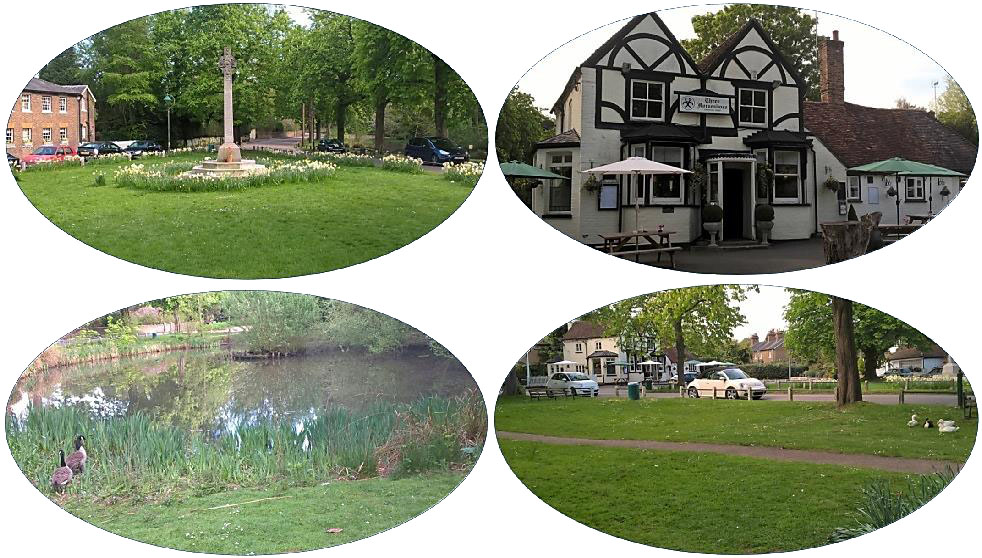
Letchmore Heath – the name Letchmore is derived from the old Saxon “leche mere” meaning muddy pond – has often been used for filming, its proximity to the studios in nearby Elstree (Borehamwood really) making it a simple to reach and cheap location. It was used widely in the 1960 science fiction/horror film Village of the Damned standing in for the eerie village of Midwich. Historically Letchmore Heath is regarded as an outlying hamlet of the parish of Aldenham, even though it has more homes, more people live there and more cars clog the streets. It has the film set looks – but then so does Aldenham – but obviously lacks a centrepiece church. What it does have, however, and it is a claim that few other villages can make, is that it is home to Bhaktivedanta Manor, one of the most important Hindu temples outside India with the annual Janmastami festival in summer – to celebrate Krishna’s birthday – attracting 50,000 people. The mock Tudor building and its grounds were gifted to the International Society for Krishna Consciousness by Beatle George Harrison in 1973 as a theological college and spiritual retreat. Today it is one of the most frequently visited Radha Krishna temples in Europe, a holy place covering 70 acres including the country’s largest fully operational organic farm and visitor centre. The Hare Krishnas openly welcome visitors. www.bhaktivedantamanor.co.uk
The manor was the subject of another film I made in the Max Files series. Maxwell Hutchinson, cameraman Vic and I spent a day recording daily life at the manor, the landscaped grounds, the revered cattle on the farm and fascinating aspects of worship. A more cordial, charming and humble people you’d be hard pushed to meet. And the manor – with its spectacular shrines – is inspiring. It is well worth a visit. Perhaps not today as there is still a way to go. And what unfolds is quite an eye-opener as the arable “back lands” and pastures between Letchmore Heath and Shenley reveal their secrets. In a way the route to Shenley can be divided into three distinct sections, split by Watling Street and Theodore Street. The first and third parts are gently rural, the middle bit scrappy and unattractive – save for one interesting moment.
Before you leave Letchmore Heath walk over to the duck pond. It is the southernmost point of the Hertfordshire Way, a mere 92 miles walking from Royston. When you get to Shenley you’ll have completed exactly half of the walk. Tired yet?
With your back to The Three Horseshoes turn left into Back Lane and then right into Common Lane. After a few minutes’ walk you’ll come to a rough path on the right with a sign saying ‘The Cottage.’ Pinpoint the roundels and continue straight on until you appear between a house on the left and a workshop/barn on your right. I always feel slightly uncomfortable walking through working farmyards, stables or skirting nosily close to people’s homes even though my Right of Way – protected by law – is, theoretically, an inviolable passage. A sheepish “Good morning” usually suffices by way of contrition as I hanker for open countryside where such forced niceties are unnecessary. Having passed between the two buildings go through a gate and along a track before crossing a drive – called Fruit Farm on maps – and continue between a red maple stained wooden stable and a white outbuilding with a paddock fence on your right. When the gravel track ends you are squeezed into a narrowing path between fences which, when I passed, was heavily overgrown. After a quick zig-zag between trees the obvious path begins to skirt a large field until it joins a wide track coming in from the left. (See below left). No chance of going astray here. At the wooded corner of a large garden walk a further 20 yards and a footpath on the right leads you straight across a field to some trees. Turn left and follow the path for 100 yards until a roundel leads you through a hedge into a field with a beautiful young orchard (below right) alongside.

Aim for the hedge opposite where a gate opens on to a large irregularly shaped field. The path, which is quite obvious, takes you diagonally across the field and over a small bridge to a metal gate and stile in the corner of the field leading on to Watling Street, arguably the greatest Roman road. It was built to link Dover and other Channel ports with London and St Albans en route to Wroxeter. Cross, turn right and walk to a clearly signposted metalled road to Kendall Hall Farm and Hertsmere Jewish Primary School. Where the road turns sharp left into the primary school grounds cross just yards into the drive to the farm where a gate immediately on your right takes you into an uneven, scrappy field – with a line of electricity pylons marching ingloriously into the distance. Walk diagonally across the field aiming for the bottom left corner below the farm buildings where another wooden gate leads you into a scrubby patch of land where, almost immediately on your right, steps take you down through the hedge to a bridleway. Turn left until you reach the depressing graffiti clad underpass which you have to walk through. Lured into a sense of despair by the grubby surroundings how surprised I was when, a hundred yards on, a delightful almost anonymous stream is crossed by a bridge (below right). Called unimaginatively The Brook on some maps it is a tributary of Tykes Water which has its source in Tykes Water Lake near Aldenham Park. Although it cannot compete with the Ver or the Colne it is a charming water course probably largely unvisited by local people. A track through a field takes you to Theodore Street.
BEWARE!!! Crossing the road here is dicing with death. But you have no choice. A perilously close blind bend on your right gives vehicles – the speed limit here is 40 mph – virtually no time to see you. And there is no pavement to walk along to get a clearer, safer view. The only recourse is to ensure that the road is clear on your left and then run like hell to the other side. It’s unavoidable. Please take care.

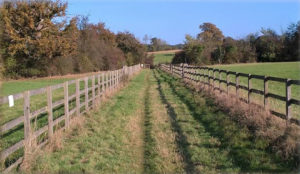 The pay back for such a hazardous crossing is the next easy and charming two mile stretch which climbs imperceptibly to your destination at Shenley Park. For the inquisitive rambler who likes to drift off the well-worn paths to explore and blaze their own trail this section will be a disappointment. The walker is largely constrained for much of the way by fences, hedges and hundreds of yards of wooden post and rail fencing enclosing paddocks for horses. While hardly on a par with the Berkshire Downs or Newmarket gallops this is clearly horse stabling and riding country. For much of the walk the Hertfordshire Way coincides with the Watling Chase Timberland Trail so signposting is excellent and the likelihood of getting lost negligible. As it is close to home I walked this section in the summer with a bonkers beagle and then alone on a beautiful autumn day. On both occasions it was a sublimely enjoyable hour. From Theodore Street walk straight ahead on a gravel path between fences (left). When it becomes grassy cross a footbridge and, after a five bar gate, continue on the well-trodden path alongside a stake and wire fence (below left). A late tall crop of – what I thought was sweet corn but with my knowledge of arable farming it could have been spaghetti – conjured up, once again for some perverse reason, that hostile low-flying crop duster dive-bombing a fleeing Cary Grant. Fittingly I was heading a bit North by Northwest.
The pay back for such a hazardous crossing is the next easy and charming two mile stretch which climbs imperceptibly to your destination at Shenley Park. For the inquisitive rambler who likes to drift off the well-worn paths to explore and blaze their own trail this section will be a disappointment. The walker is largely constrained for much of the way by fences, hedges and hundreds of yards of wooden post and rail fencing enclosing paddocks for horses. While hardly on a par with the Berkshire Downs or Newmarket gallops this is clearly horse stabling and riding country. For much of the walk the Hertfordshire Way coincides with the Watling Chase Timberland Trail so signposting is excellent and the likelihood of getting lost negligible. As it is close to home I walked this section in the summer with a bonkers beagle and then alone on a beautiful autumn day. On both occasions it was a sublimely enjoyable hour. From Theodore Street walk straight ahead on a gravel path between fences (left). When it becomes grassy cross a footbridge and, after a five bar gate, continue on the well-trodden path alongside a stake and wire fence (below left). A late tall crop of – what I thought was sweet corn but with my knowledge of arable farming it could have been spaghetti – conjured up, once again for some perverse reason, that hostile low-flying crop duster dive-bombing a fleeing Cary Grant. Fittingly I was heading a bit North by Northwest.
The path becomes constricted between bushes as it bends and then heads right skirting a fenced enclosure (bottom left) until you reach a wood ahead of you and a private drive on your left. Turn right and drop downhill towards a metal gate. A prominent Watling Chase Timberland Trail sign -adorned with the Hertfordshire Way roundel of course – sends you left through a small wood. Note the very tall old pines on your left. The path emerges alongside another fence which leads to a gate where you bear left, corralled in between paddocks. The views here are increasingly impressive (bottom right) as you gain a bit of height, the skyline dominated by the old Shenley Hospital water tower.


The track reaches Woodhall Lane where you turn right and walk a third of a mile, passing Kitwells Lodge on the right, until you reach another blindingly obvious Timberland Trail sign which points left towards Shenley. It announces it is three quarters of a mile to Shenley tea rooms so journey’s end is nigh. Simply follow the direct track through the woods passing the immature Woodhall Spinney – complete with benches and planted in 2013 -until you emerge at Radlett Lane. Cross and take one of the two paths left to the tea rooms.


The tea rooms, correctly called Café in the Orchard www.intheorchard.co.uk, are part of Shenley Park, a former private estate called Porters Park which became the site of a mental hospital. The park features an orchard, meadow, woodlands walks, historic buildings and a two acre walled garden with an amphitheatre. But it’s been a long slog from King’s Langley and tea and cakes are likely to be your primary concern.
After an unprepossessing start the leg improved once Bricket Common was reached and then became an amiable amble through fields and film set villages. Having reached Shenley you have now completed HALF of the 195 miles. A laudable accomplishment but don’t slip into complacency. There’s a lot more to come – either way!!!
Next: Leg 9 Shenley to Cuffley. A curate’s egg of a walk. With some intriguing surprises